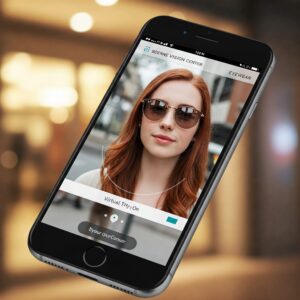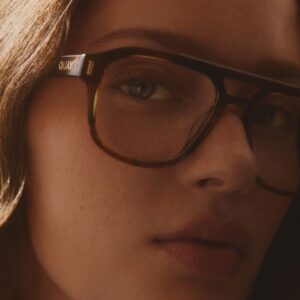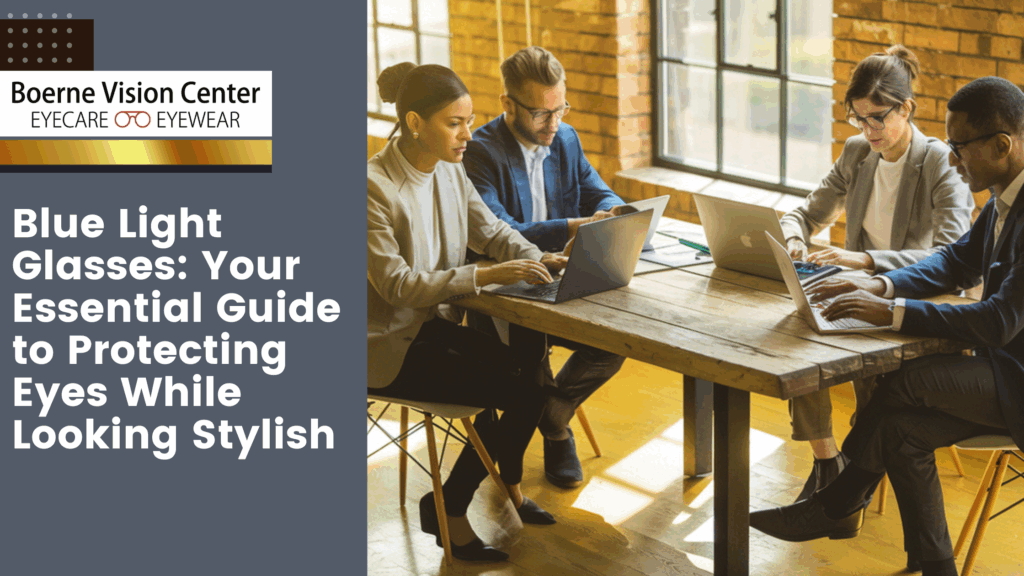Introduction
Screen time has become a constant companion in our daily lives. Working at computers, scrolling through social media, or enjoying your favorite shows exposes your eyes to blue light for hours each day. That’s why blue light glasses have emerged as must-have accessories for the digital era.
“Do blue light glasses actually work?” and “What do blue light glasses do?” These questions come up often during our patient consultations. Your curiosity makes perfect sense. Blue light blocking glasses are specially crafted to filter out potentially harmful blue light from digital screens—the kind that might lead to tired eyes, headaches, and disturbed sleep patterns. While scientists continue studying their effectiveness, our patients tell us they notice real relief when wearing glasses matched to their specific needs.
Let’s walk through everything you should know about blue light glasses—both prescription and non-prescription varieties. We’ll guide you toward stylish options that protect your vision without sacrificing your personal style. Looking for “blue light glasses near me”? We’ve included helpful selection tips and recommendations to make your search easier and more successful.
What Are Blue Light Glasses and How Do They Work?
Blue light glasses aren’t just a fashion trend—they’re specially crafted eyewear designed to filter blue light coming from your digital screens. Their growing popularity stems from genuine concerns many of our patients express about potential eye damage from long hours spent looking at screens. 
Let’s talk about blue light itself. This high-energy light occupies the short wavelength portion of the visible light spectrum, between 400 and 500 nanometers. While the sun naturally bathes us in blue light, your devices—computers, smartphones, and LED lighting—also emit significant amounts daily.
The magic happens in the lenses. Quality blue light glasses use special technology that filters or blocks specific light wavelengths. Most glasses designed for daytime wear filter roughly 40-50% of blue light while allowing beneficial light to pass through. Look closely at these lenses, and you’ll find special pigments targeting the most energetic wavelengths—particularly those between 440-455nm, which eye care specialists consider potentially most concerning.
We should note that despite their popularity, the science behind these glasses presents a mixed picture. Several studies haven’t found definitive proof that blue light-blocking glasses reduce digital eye strain symptoms. One recent study from 2021 followed 120 computer users and noticed no meaningful difference in eye comfort between people wearing blue light filters versus regular clear lenses.
Sleep quality tells a different story, though. Blue light exposure in evening hours can disrupt your body’s melatonin production—that crucial hormone that tells your brain it’s time for sleep. That’s why nighttime blue light glasses typically block 100% of blue light, sometimes extending to green light wavelengths up to 550nm.
The American Academy of Ophthalmology hasn’t yet recommended blue light-blocking glasses, citing limited scientific evidence that screen-emitted blue light actually damages eyes. Your everyday devices emit only a tiny fraction—between 0.4% and 4%—of blue light considered safe by international standards. 
Many eye care professionals, ourselves included, believe digital eye discomfort might stem more from how we use our devices rather than the blue light itself. Poor posture, insufficient blinking, and improper viewing distances often contribute significantly to what many call “digital eye strain.”
How to Choose the Best Blue Light Glasses for Your Needs
Finding your perfect pair of blue light glasses means balancing protection, comfort, and personal needs. Your selection journey should begin with the filtering rate—we typically suggest glasses that filter at least 80% of blue light at 420 nm for the best protection. Your daily screen habits matter too; when you spend more than 4 hours facing digital devices, we recommend choosing glasses with over 40% filtration at 430 nm. 
The color of your lenses plays a crucial role in how your glasses perform. For daytime wear, clear or yellow-tinted lenses work wonderfully, filtering harmful light while letting beneficial wavelengths reach your eyes. Evening screen time calls for amber lenses that block 100% of blue light, helping your brain prepare for restful sleep. Some of our patients with particular sensitivity choose red lenses for maximum protection, as these block both blue and green light up to 550nm.
We’ve found that frame quality deserves just as much attention as lens technology. Your comfort during long work sessions depends on lightweight materials—Italian-designed acetate or premium stainless steel often provide the best experience. Many of our clients appreciate flexible spring hinges and adjustable nose pads that create a truly customized fit.
You’ll be pleased to know that prescription-free options work perfectly well for blue light protection. If you already rely on corrective lenses, don’t worry—many quality retailers offer blue light filtering combined with your prescription. Even contact lens wearers can find brands offering blue light blocking features.
We always encourage our clients to verify the effectiveness of their glasses by requesting a transmittance spectrum report. This detailed report shows exactly which wavelengths are filtered and by what percentage. For everyday use, we recommend glasses that filter at least 50% of light in the 300-500 nm range.
Pricing varies considerably, with designer frames sometimes exceeding $100, though adding blue light technology typically adds about $40 to standard lenses.  Many of our clients are pleasantly surprised to learn that their vision insurance plans often cover blue light filtering lenses—we suggest checking with your provider before making your purchase.
Many of our clients are pleasantly surprised to learn that their vision insurance plans often cover blue light filtering lenses—we suggest checking with your provider before making your purchase.
How to Stay Stylish While Protecting Your Eyes
 Good news! Protecting your eyes doesn’t mean sacrificing your sense of style. The fashion elements of blue light glasses have come a long way, with today’s brands offering beautiful designs that complement your unique features while caring for your vision.
Good news! Protecting your eyes doesn’t mean sacrificing your sense of style. The fashion elements of blue light glasses have come a long way, with today’s brands offering beautiful designs that complement your unique features while caring for your vision.
Your face shape plays a key role in finding flattering frames. Heart-shaped faces with angular features look softer with square or aviator styles. Diamond faces gain balance from round, oval, or cat-eye frames. Round faces benefit from rectangle and geometric frames that add definition to softer features. Those blessed with oval faces enjoy the most flexibility—nearly any frame style will look wonderful on you.
When browsing for your perfect pair of stylish blue light glasses, look for these trending options:
- Classic shapes with modern twists – Subtle cat-eye curves or bold square frames come in dozens of translucent shades and patterns to suit your personal taste
- Lightweight designer frames – Some weighing as little as 0.5 ounces feel comfortable all day while looking elegant
- Eco-conscious materials – Feel good about your choice with frames crafted from recycled resin, responsibly sourced wood, or cotton-based acetate
Many of our trusted retailers now offer virtual try-on features, letting you see exactly how frames will look on your face before you make your purchase. This helpful tool makes finding frames that match your personal style remarkably simple.
This helpful tool makes finding frames that match your personal style remarkably simple.
Shopping for blue light glasses today feels just like selecting any fashion eyewear. The best brands understand that protection and style belong together, creating everything from subtle clear frames that complement any outfit to bold designs that make a statement.
Remember to balance function with fashion when making your choice. Lightweight, comfortable frames prevent discomfort during long screen sessions, while still letting you select designs that enhance your look. With so many colors, shapes, and styles now available, finding blue light glasses that feel uniquely “you” has never been easier.
Conclusion
The Bottom Line on Blue Light Protection
Blue light glasses offer a practical option for daily screen users worried about their eye health.  We’ve explored how these special lenses filter potentially harmful light wavelengths throughout this guide, acknowledging the ongoing scientific conversation about their effectiveness. We’ve also shared what matters most when choosing your perfect pair—everything from filtering capabilities and lens tints to comfortable frames and stylish designs.
We’ve explored how these special lenses filter potentially harmful light wavelengths throughout this guide, acknowledging the ongoing scientific conversation about their effectiveness. We’ve also shared what matters most when choosing your perfect pair—everything from filtering capabilities and lens tints to comfortable frames and stylish designs.
Our patients who spend long hours in front of screens often tell us they experience noticeable relief when wearing quality blue light glasses. Your comfort might improve even as researchers continue studying these products. Finding the right balance between protection and wearability ensures you’ll actually use them consistently—the most important factor in any eye care solution.
Your style preferences deserve just as much attention as the protective features.  Today’s fashionable frames complement your unique face shape while providing the filtering technology your eyes might appreciate. Many of our patients discover their blue light glasses become favorite accessories rather than just functional eye protection.
Today’s fashionable frames complement your unique face shape while providing the filtering technology your eyes might appreciate. Many of our patients discover their blue light glasses become favorite accessories rather than just functional eye protection.
Protecting your vision matters tremendously in our screen-filled world. Blue light glasses represent one valuable option among several eye care practices. We recommend pairing them with healthy screen habits—taking regular breaks, ensuring proper lighting, and maintaining appropriate viewing distances. The ideal pair brings together eye protection, daily comfort, and personal style, letting you care for your vision without sacrificing how you present yourself to the world.


